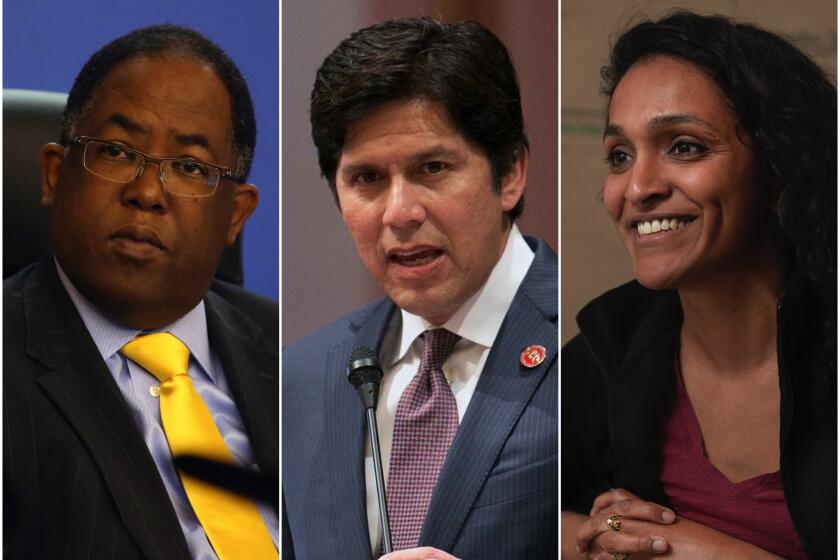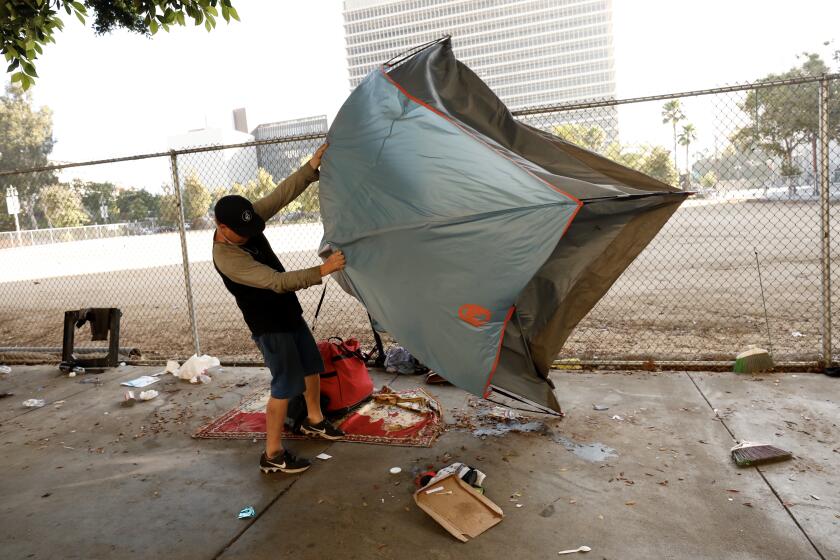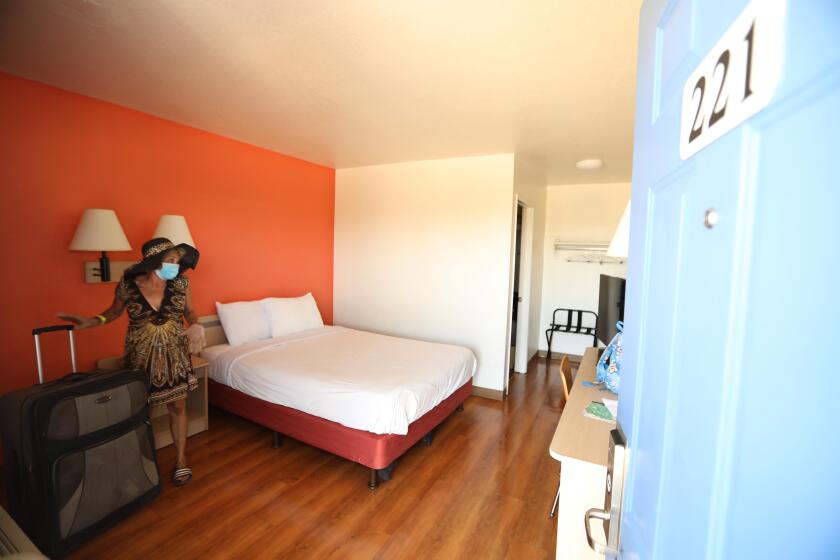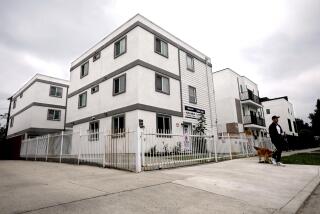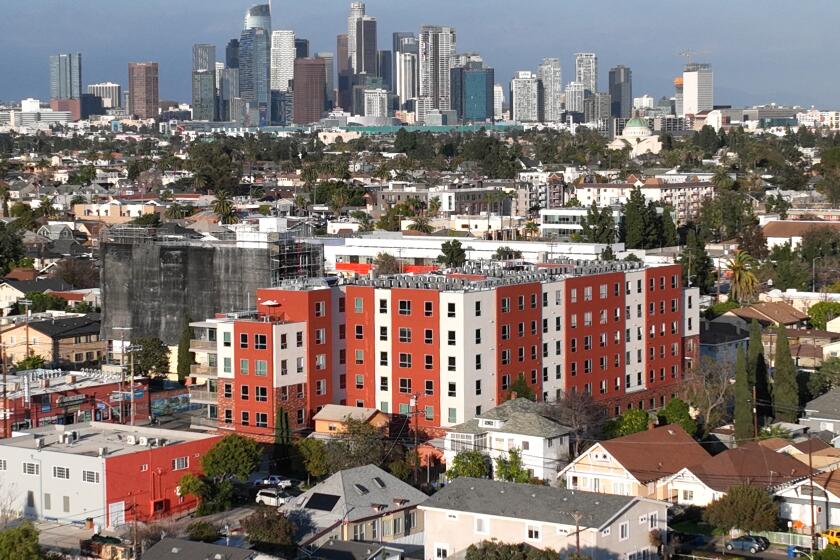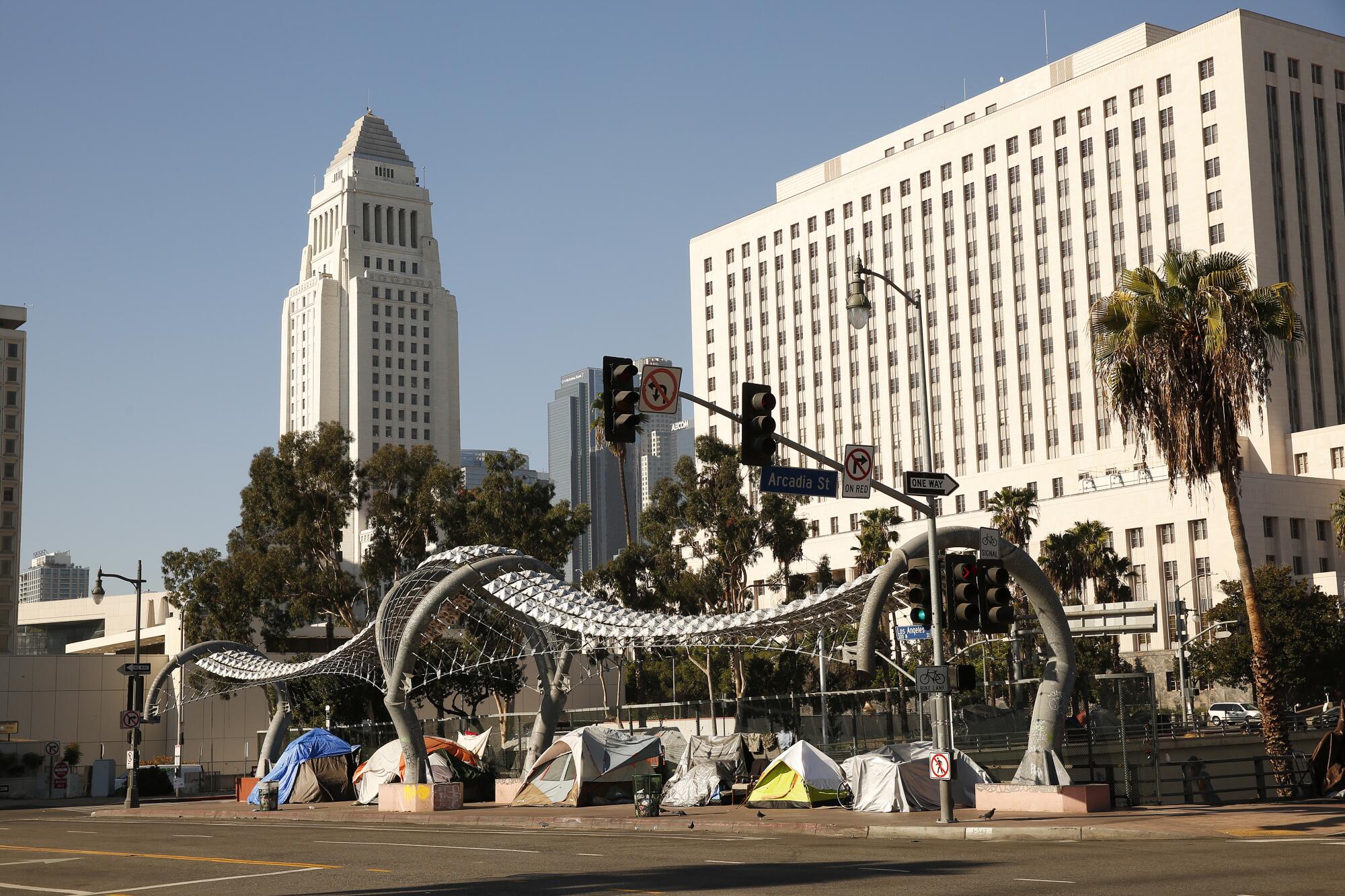
- Share via
In the spring of 2018, Los Angeles Mayor Eric Garcetti put his personal stamp on the city’s response to homelessness by announcing a departure from its primary focus of building permanent housing. Garcetti proposed to open a homeless shelter in each of L.A.’s 15 council districts.
Garcetti has largely made good on that goal, defying the skepticism that greeted his plan, called A Bridge Home. Rallying council members to the cause and making deals for public and private land from San Pedro to Canoga Park, the mayor has opened at least one shelter in all but one council district. So far, 20 are up and running and five more are nearing completion. By early next year they will have added nearly 2,000 new shelter beds to the city’s inventory.
But a Times review shows that Garcetti’s signature homelessness program, which has cost about $200 million, has had less success living up to its promise to move people on the streets into permanent housing and improve the communities around the shelters with enhanced policing and increased sanitation services.
“They told us we would have cleaner neighborhoods if we accepted this,” said Christina Tullock, who cares for her ailing mother in a condo across the street from the shelter in Venice. “Exactly the opposite has happened.”
Where she lives, encampments have grown, crime is up and residents live in fear. She said she can’t take her mother for a walk and sleeps with a baseball bat: “I’m scared.”
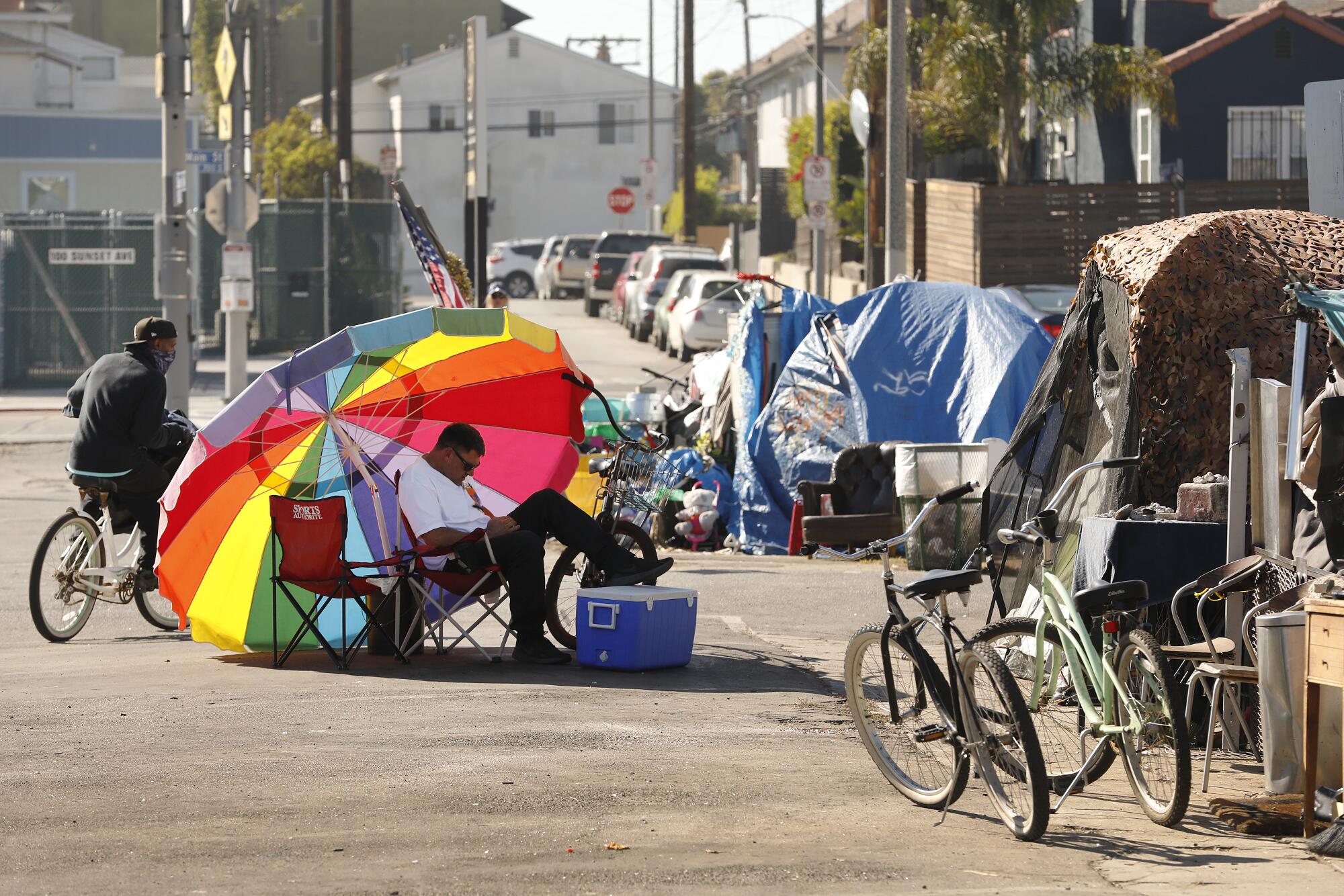
Moreover, data provided to The Times by the Los Angeles Homeless Services Authority, which manages the shelter service contracts, show that the program isn’t coming close to Garcetti’s goal of having shelter residents stay only three to six months, then move on to permanent housing. The mayor has set a goal of ending homelessness in Los Angeles by 2028.
Of nearly 1,500 people who were in the shelters and left through early November, only 15% moved on to permanent housing. In contrast, two-thirds either went back to the streets or left without saying where they were going.
In an interview, Garcetti acknowledged disappointments but said A Bridge Home has begun to fill a gap in the city’s homeless housing options and will improve with time.
The L.A. City Council’s three newest members bring experience on homelessness
“To me, the last 18 months was about building these,” he said. “I think the next 18 months is about managing them and setting up a system, some of which we control, some of which we don’t.”
The mayor said he understood that residents have legitimate concerns about crime and unhealthful conditions and that those may have been exacerbated by the decision to pull back the dedicated police patrols he initially promised around the shelters. He said Police Chief Michel Moore advised him that the officers patrolling the sites were not being used efficiently because there was little for them to do.
Garcetti said the shelters are still receiving a “priority” response.
Supporters of the decision said it was needed to maintain cleanliness and keep promises that city leaders made to neighbors. Critics said it would put homeless people at greater risk during the pandemic.
Sidewalks are clean around a majority of the shelters, which tend to be on major streets or industrial areas separated from residential neighborhoods. But homeless encampments have persisted or even spread around a few, alarming and frightening people who live nearby.
The shelter in Venice, pushed through by Garcetti and Councilman Mike Bonin over intense opposition, has been a particular problem, outraging residents who email city officials and news outlets almost daily with complaints about crime, drug dealing and fires in the tents and tarp shelters that line nearby streets posted as a special enforcement zone. Between late February, when the shelter opened, and last week, the LAPD said there had been an 88% increase in violent crime in an area surrounding the shelter compared with the same period last year.
Tullock, who describes herself as a supporter of the shelter, nonetheless said she sees residents of the shelter who still keep belongings on the street and hang out there during the day.
“Having the encampments next to the Bridge Home is directly in opposition to what they’re trying to do,” she said.
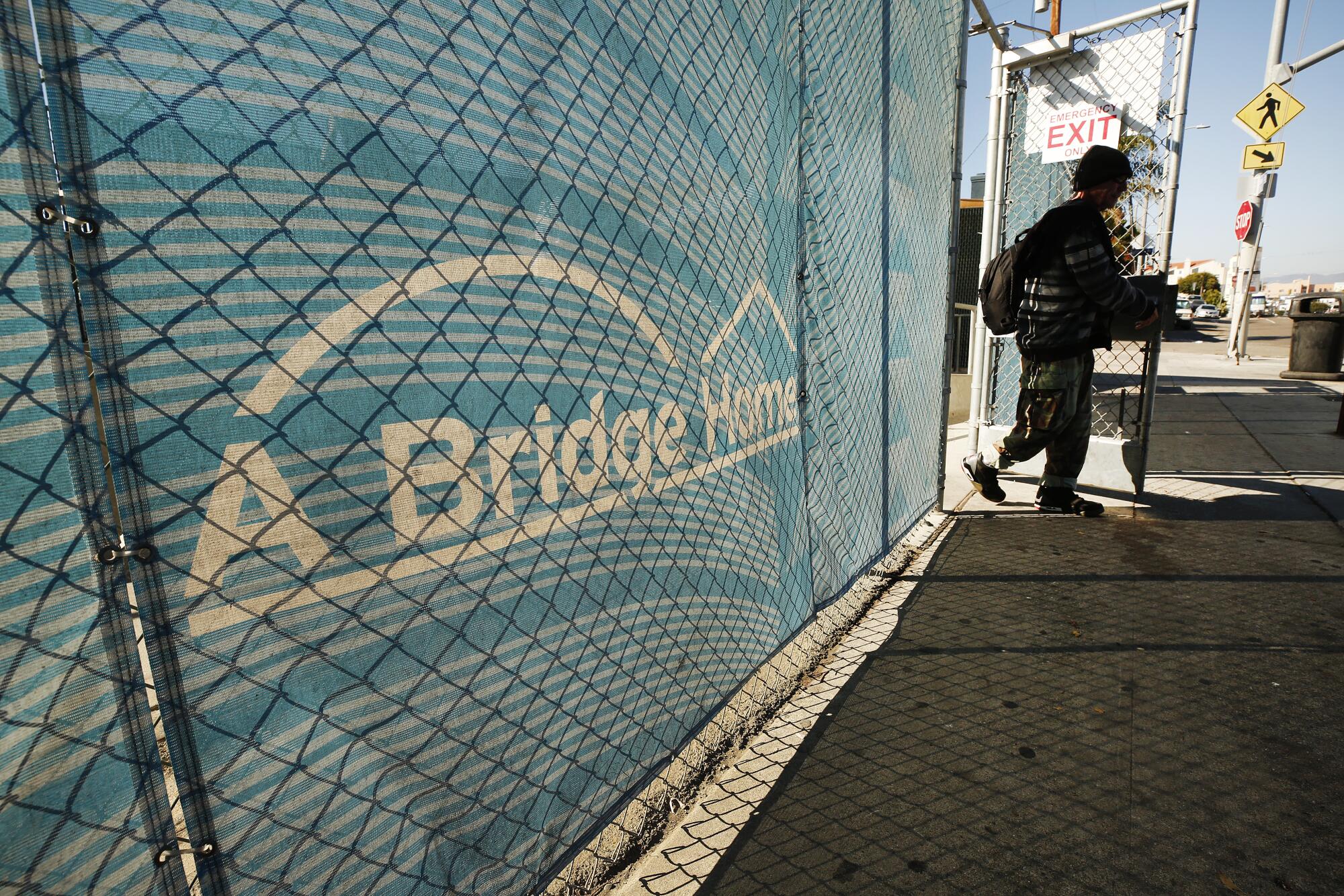
Encampments also still line the sidewalks around El Puente, a downtown shelter near Olvera Street that was the first of the new sites to open, and on Aetna Street near the Van Nuys Civic Center.
Varoojh Darabdian, who owns a body shop a block from the Van Nuys shelter, said the city officials who sought his support for the shelter have failed to deliver on their promise that the homeless encampments in front of his business would be cleaned up.
“This is a bad situation,” he said. “It gets worse.”
A block from El Puente, on a bridge running over the 101 Freeway, Eric Davido sat outside his tent in a Dodgers cap, forlorn, smoking methamphetamine and listening to jazz. The 60-year-old said he has been homeless for 20 years, struggling with addiction, and at the outset of the pandemic got a placement in El Puente.

“They said they wanted to keep me there as long as I was getting my life in order — getting my birth certificate, things like that,” Davido said. But over the summer, he said, he got into a confrontation with a security guard and returned to the area where he had bedded down before.
In Venice, a man who gave his name only as Arkansas similarly participated in the revolving door from street to shelter, then back to the street.
In the shelter, he said, he had belongings stolen and chafed at the rules about when he could come and go. So he left and received a 14-day motel voucher, but then he was back on the street.

“I’m a night owl. That is when I wanna be out and about,” he said. “How are they gonna keep me inside?”
There have been success stories, such as a North Hollywood shelter that won over its next-door neighbor by beefing up security.
“There was a problem that some people were hanging out in front of the building and not doing good things,” said the owner of the adjacent building, Robert Freeman.
Freeman said he confronted the shelter operator, Hope of the Valley. He was so pleased with the response that he made a donation to the organization.
Garcetti said shelters that prove problematic, such as Venice or Hollywood, may be scaled back, moved or even eliminated.
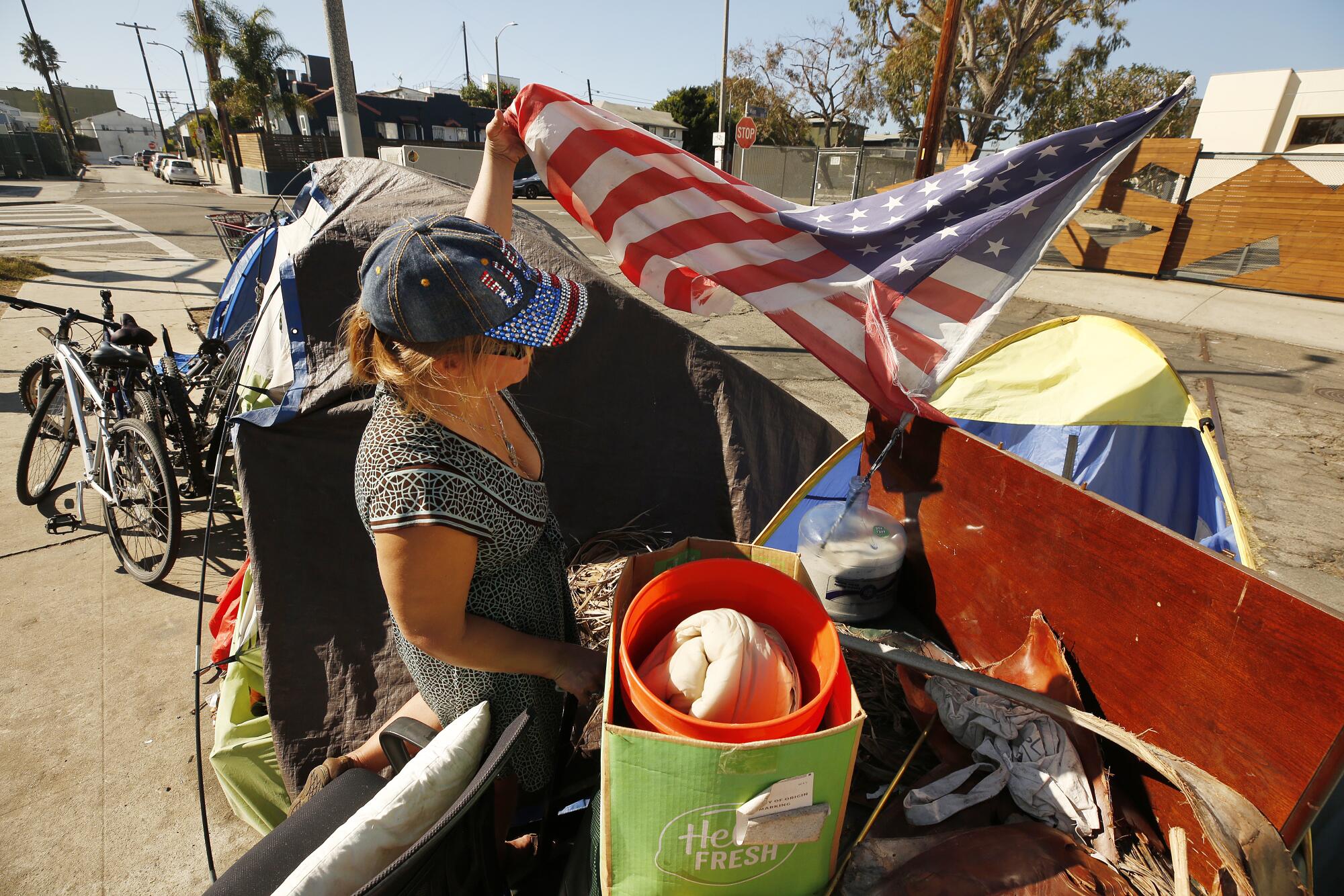
Though he structured A Bridge Home as a three-year program, the mayor said he expected many of the shelters to stay open longer.
“If the community wants it for longer, or we collectively decide that we want it for longer, let’s do it,” he said.
The homeless services providers that operate the shelters say they are not daunted by the growing pains.
“Overall I think it’s great,” said Stephanie Klasky-Gamer, president and chief executive of L.A. Family Housing, which will operate two shelters in the San Fernando Valley. “What I think is most positive about it is they are popping in every council district. I think it was a tough promise to make and therefore keep.”
Los Angeles City Councilman Curren Price has proposed turning the downtown Convention Center into a homeless shelter while it sits vacant during the pandemic.
“We will see improvement,” said Jennifer Hark-Dietz, deputy chief executive of PATH, a statewide homeless services provider and supportive housing developer. PATH operates six of the shelters.
The data provided by LAHSA showed that 31% of those leaving the shelters went back to the streets and 35% to unknown destinations. An additional 13% found other temporary housing, either with friends or family or in a program; 4% checked into a mental hospital, detox program or nursing facility; 2% went to jail; and seven — less than half a percent — died.
Fewer than half the placements in permanent housing included supportive services, such as case management and housing assistance. Most were in subsidized rentals or with family or friends.

LAHSA’s executive director, Heidi Marston, said it’s not surprising that so many people left without receiving permanent housing.
“Nationally you see about 75% of exits have been to unknown locations,” Marston said, reflecting the fact that residents are free to come and go as they please and that there isn’t enough subsidized housing for those who need it.
Marston said the new shelters, with partitioned sleeping areas, pet accommodations and ample space for case managers and housing navigators, should prove more effective over time.
The shelters were designed to provide “access, dignity, healing, and giving people the space that they need,” an improvement over the typical shelter with dozens to hundreds of people in a large open space, Marston said in an interview.
Several shelters had COVID-19 outbreaks, prompting quarantines. Others were forced to reduce the number of beds to adhere to public health guidance.
People in the shelters were sometimes moved into hotels that the county and city had rented through a statewide program, Project Roomkey. At its peak that effort housed nearly 4,000 homeless people, but it’s now being shut down.
The long-term viability of A Bridge Home is hardly assured. The program is burdened by a slow start and ballooning costs. Initially funded by $20 million, its budget has grown, largely with emergency state funding, to nearly $187 million, of which about $30 million is for operating costs.
After reaching less than 30% of its goal to shelter homeless people who are vulnerable to the coronavirus, Project Roomkey is starting to phase out in the face of funding uncertainty.
Los Angeles County has pitched in a three-year commitment to fund about 800 beds, fewer than half the total, leaving the city dependent on continued state money to keep the shelters running.
Some of the shelters are inherently longer-lasting than others.
About half the shelters are in commercial-style tents that are partitioned inside for individual sleeping pods. Though they could be quickly dismantled, they are manufactured to last 25 years. The city owns the structures and could relocate them if needed.
The nine on city-owned land could be maintained indefinitely. Eight others have been placed on land the city has leased for three years from other agencies, including the state of California, the L.A. County Metropolitan Transportation Authority and the L.A. Department of Water and Power.
Two shelters are in buildings owned by the city that have been rehabbed as shelters: the former Gardner Library in the Fairfax district and the former Children’s Museum in the Los Angeles Mall downtown.
The mayor’s A Bridge Home website shows 23 completed sites and six in development. But three of those sites are not actually part of A Bridge Home. One is a county shelter opened by Supervisor Janice Hahn. One, on a vacant lot owned by the city Housing Authority, has been committed to permanent housing. A 42-bed residence operated by the nonprofit Aviva currently has 15 residents funded by motel vouchers after LAHSA rejected Aviva’s application on technical grounds.
Times staff writer Dakota Smith contributed to this report.
More to Read
Sign up for Essential California
The most important California stories and recommendations in your inbox every morning.
You may occasionally receive promotional content from the Los Angeles Times.
